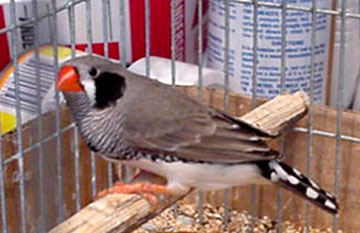Finch - Zebra
Scientific Name: Taeniopygia guttata
Sat, 26th April, 2025 - 5:14 pm GMT
Sponsor Ads:

Alternative Name
Scientific Name: Taeniopygia guttataBasic Info
The Zebra Finch is colorful and quite lovely to behold. There are several different color variations for the Zebra Finch including white, white-gray, milk chocolate, silver, and fawn. All of these color varieties can occur with pied markings as well. Males and females can be easily distinguished by the color of their beaks. Females exhibit orange beaks while the male's beak is red. Males also show black chest stripes, chestnut flanks and ear patches and bright orange cheek spots, females usually lack these markings. In addition the female is usually significantly duller than the male. Some color mutations may produce males and females which exhibit the same color patterns, but one can always rely on the differences in beak coloring to make distinctions. One of the most beautiful Zebra Finches is the crested Zebra Finch, which comes in two color varieties. The Zebra Finch is very small averaging only 9cm at maturity.
Health
Zebra Finches are generally healthy birds. Some things to watch for include; illness (one sign of an ill bird is lethargy or puffiness, many birds will display no symptoms when ill), keeping nails short (this usually will happen naturally), leg bands that fit properly, strings hanging from toys (strings can be very dangerous and should never be used without supervision). A balanced diet and clean living conditions will contribute to keeping your Zebra finch healthy and happy for many years. Breeding Zebra Finches are one of the easiest birds to breed. Being a rapidly maturing creature the Zebra Finch is reading for breeding as early as 11 - 12 weeks. Most will recommend waiting until at least six to nine months of age before beginning a breeding program. Most Zebra Finches will breed in nests; one can use a wicker nest or a breeding box with a small hole in the opening. The hen will typically lay three to eight eggs with an incubation period of about two weeks. Chicks can safely be removed from the nest at five to six weeks of age.Habitat
Commonly seen in Australia's grasslandsBehavior
The Zebra Finch has been called the most popular bird in aviculture. The Zebra Finch is one of the heartiest finches, making it a good choice for beginners and experts alike. He possesses a cheerful happy disposition, yet Zebra Finches are fairly shy around people, they do not like to be held or pet like some other bird species. There are always exceptions to this rule, however, if you are looking for a pet bird you can hold you should probably not buy a Zebra Finch. Because they are social creatures, it is recommended that they be kept in pairs. One of the Hallmarks of this breed is his chirping song. It should be noted that males are typically superior in singing ability to females. Some females will never sing at all. If treated with hormones after hatching females can be altered to sing much as males. The Zebra Finch is a highly active bird, and it is recommended he be allowed plenty of space within his cage or indoor aviary to fly freely. This space should never fall below 18-20 inches square.Origin
AustraliaHistory
The Zebra Finch originates in Australia. They wild Zebra Finch is commonly seen in Australia's grasslands. Today Australia prohibits the exportation of most animals, hence most of the Zebra Finches you see around the world were captive bred outside of their native country. The wild Zebra Finch is a social bird typically seen traveling in large flocks. The diet of the wild finches consists of fresh foods and bugs.Common Foods
Because of their high energy it is particularly important to maintain a healthy diet consisting of fresh seed mixes (with a variety of different seeds), millet, dried or fresh greens, and other low fat fresh foods. Food supplements such as petamine and neSponsor Ads:
The greatest of all faults is to be conscious of none -- Thomas Carlyle 1795-1881
Finch - Zebra
Coded by: BGID® | ALL RIGHTS RESERVED Copyright © 2000-2025
Disclaimer | Privacy | Report Errors / Contact | Credits


 Why haven't we as a collective earth met with aliens yet?
Why haven't we as a collective earth met with aliens yet?  The Best Text Adventure You Will Ever Play! The official site:
The Best Text Adventure You Will Ever Play! The official site:  Homosexual behavior stems from the mind or genetics?
Homosexual behavior stems from the mind or genetics?  World EcoSystem - Biodiversity Changes - Who is on board and who isn
World EcoSystem - Biodiversity Changes - Who is on board and who isn  Mouthwash - Mouthrinse - Mouth Sores - Healing Infections - Gingivitis
Mouthwash - Mouthrinse - Mouth Sores - Healing Infections - Gingivitis  Treatment for Depression
Treatment for Depression  Ultra radical and violent Islamist group that even rivals Al Qaeda
Ultra radical and violent Islamist group that even rivals Al Qaeda  An idea to have teachers who want to carry guns to school undergo some level of police training will be left up to local school districts and police departments.
An idea to have teachers who want to carry guns to school undergo some level of police training will be left up to local school districts and police departments.